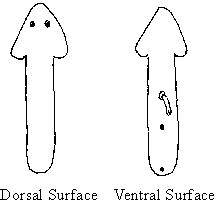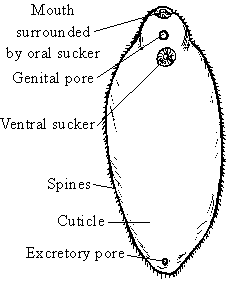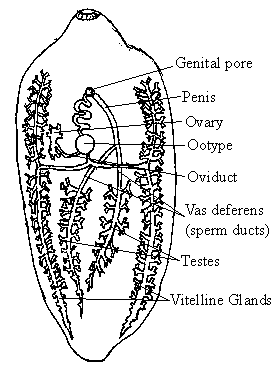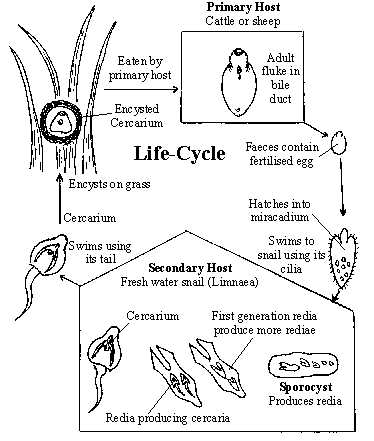Education Links
Leaving Cert
 Maths
Maths
 French
French
 English
English
 Chemistry
Chemistry
 Physics
Physics
 Biology
Biology
 Economics
Economics
 Spanish
Spanish
 Geography
Geography
 History
History
Junior Cert
1. Flattened body.
2. Triploblastic acoelomate.
3. Mouth but no anus.
4. Flame cells for excretion.
5. Bilateral symmetry.
6. No circulatory system (because of flattened body circulation is carried out by diffusion).
There are three classes of flatworm:
a) Free living flatworm e.g. Dugesia (see panel on right)
b) Parasitic fluke e.g. Liver Fluke
c) Parasitic tapeworm.
Dugesia
Dugesia (Planaria) is a free living flatworm. It is found on the bottom of fresh water streams and ponds. It remains under stones during the day emerging at night to feed. It feeds on small worms and dead animals. External structure:
External structure:Adaptions to its mode of living:
Liver Fluke (Fasciola Hepatica)
External structure
Reproductive system

The liver fluke is hermaphrodite, i.e. it contains both male and female reproductive organs in the one body.
Male system
Female system
Life cycle

It involves two different hosts:
A primary host (sheep or cattle) and a secondary host (fresh water snail/mud snail)
1. Sexual reproduction - in the bile duct of the primary host.
(a) A single fluke can produce up to 20,000 fertilised eggs per day.
(b) The eggs are released from the primary host with the faeces.
2. Finding a secondary host - external environment
(a) Light, moisture, and a temperature above 10 degrees Celcius are required for the fertilised eggs to hatch into the first larval stage, the miracidium.
(b) The miracidium has cilia to help it swim and has 24 hours to find a snail.
3. Asexual reproduction (polyembryony) - in the secondary host.
(a) The miracidium uses its spine to penetrate the snail.
(b) Each miracidium develops into a sporocyst.
(c) Each sporocyst produces many redia asexually.
(d) Each redia can produce many rediae.
(e) Each redia can produce many cercaria.
(f) The cercaria leave the snail.
4. Finding a primary host - external environment.
(a) The cercarium swims by means of its tail to a blade of grass.
(b) It forms a cyst about 0.25mm in size.
5. The adult matures - In the primary host.
(a) The encysted cercaria are ingested by the primary host.
(b) An immature fluke emerges from the cyst, burrows through the intestinal wall and migrates to the liver.
(c) Young flukes feed and grow in the liver.
(d) When sexually mature the adults enter the bile duct and copulate.
Economic and medical importance
The liver fluke can have some serious effects on the host:
Controlling the Liver Fluke
| Method | Stages of life cycle affected |
| 1. Drain the land |
(a) Snail is absent, miracidia die. (b) Encysted cercaria die after 6 weeks (can normally live for 12 months). |
| 2. Dose the primary host | This kills the adult flukes in the primary host. |
| 3. Spray molluscides | This kills the snails, miracidia die. |
| 4. Fence off wet areas |
(a) Encysted cercaria die eventually. (b) Miracidia die - no snails in dry areas. |
| 5. Spread lime on the land | Lime increases the pH. If pH is greater than 7.5 the eggs will not hatch into miracidia. The fertilised eggs die. |
| 6. Introduce ducks and geese | They eat the snails, miracidia die. |
Adaptations of the Liver Fluke
1. Suckers: Attachment to the primary host.
2. Spines: Attachment to the primary host.
3. Cuticle: Protection.
4. Hermaphrodite:
(a) Any fluke can produce a fertilised egg (doubles the population).
(b) Cross fertilisation can take place leading to increased variation.
(c) Self fertilation can take place.
5. 20,000 eggs produced per day: To increase chances of some surviving and gaining access to the secondary host.
6. Light needed for eggs to hatch:
Ensures eggs only hatch once outside the primary host. This gives the miracidium the full 24 hours to locate a snail.
7. Cilia on miracidium: Enables it to swim to secondary host.
8. Spine on miracidium: To help penetrate the snail.
9. Asexual reproduction in the water snail: Increase chances of some cercaria gaining access to the primary host.
10. Tail on cercarium: Enables it to swim to the top of the grass.
11. Cyst: This protects the cercarium so prolonging its lifespan.
Sample Question
Outline where and why a build up of parasite numbers occur in the life cycle of the liver fluke.Solution:
Where?
1. In the cow or sheep; sexual reproduction leads to the production of 20,000 fertilised eggs per day.
2. In the water snail (asexual reproduction - polyembryony); One sporocyst produces many redia. One redia produces many rediae. Each redia produces many cercaria.
Why?
1. The 20,000 eggs increase the chances of some surviving and gaining access to the secondary host.
2. Polyembryony in the snail increases the chances of some cercaria gaining access to the primary host.
Therefore the build up of numbers greatly increase the chances of gaining access to a new host.
Leaving Cert. Higher Level Examination Questions
1985 Question 8, 1987 Question 11, 1989 Question 15(c), 1991 Question 9(b), 1993 Question 3(a), 1994 Question 11(a), 1996 Question 8.

